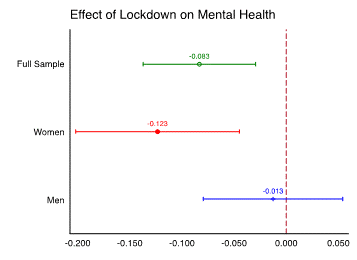#EconomicPolicy
#EconomicPolicy73
#CovidEconomics
Lockdowns Widen the Gender Gap In Mental Health
American evidence from Spring 2020 stay-at-home orders
The mental health of American women has suffered far more from lockdown and social distancing measures than men’s, according to new research by Abi Adams-Prassl (University of Oxford), Teodora Boneva (University of Zurich), Marta Golin (University of Oxford) and Christopher Rauh (University of Cambridge).
Their analysis of geographically representative survey data collected in the early months of the pandemic reveals that by mid-April, there had been a large worsening in mental health in US states that had ‘stay-at-home’ orders in place compared with states that had not introduced official lockdowns. The negative effect of state-wide stay-at-home measures on mental health was driven entirely by women.
The widening gender gap cannot be explained by respondents earning less than usual, working less than usual, losing their job, struggling to pay their bills or changing their work patterns or number of hours spent on childcare. What’s more, it cannot be explained by the severity of the crisis, in terms of cases and deaths, in a respondent’s county.
More…
The coronavirus pandemic has affected life and wellbeing in a number of ways. Not only can infection directly worsen health, but social isolation has also led to deterioration in mental health, particularly among women.
In order to understand the role that public policy plays for mental health, the new study looks at how the imposition of a lockdown affects someone’s psychological state. The authors compare the mental condition of people that living in US states that imposed stay-at-home orders with that of people living in states with no such restrictions. The fact that the decision to impose a lockdown lies in the hands of state governors makes it possible to do this comparison.
The authors use three waves of geographically representative survey data collected in the United States in March, April and May 2020, with a total of 12,010 respondents. While at the time of the first survey only 14 states had stay-at-home orders in place, this number rose to 40 by the time of the April survey. By the end of May 2020, 24 states had eased their stay-at-home orders. These changes within and across states in the imposition of stay-at-home orders makes it possible to study the effect of these measures on mental health.
To measure mental health, the study uses the World Health Organization’s five-question module. These questions capture feelings and sentiments of the current state of mind and the index performs well as a tool to screen individuals who experience symptoms, or are at risk, of depression and anxiety. In the absence of pandemics and lockdowns, women already tend to have worse mental health, as the study’s data for March show.
By mid-April, a large worsening in mental health was evident in states that had stay-at-home orders in place compared with states that had not introduced official lockdowns. The negative effect of state-wide stay-at-home measures on mental health was driven entirely by women, as Figure 1 shows. The gender gap increased by almost two-thirds of the pre-lockdown gap.
On first sight, it might appear be an unsurprising finding given that women also suffered more in the job market and took on a larger share of home schooling. But the gender gap cannot be explained by respondents earning less than usual, working less than usual, losing their job, struggling to pay their bills or changing their work patterns or number of hours spent on childcare.
In addition, the severity of the crisis, in terms of cases and deaths, in a respondent’s county cannot explain the widening gender gap. It appears that women’s mental health suffered more from lockdown and social distancing measures that were put in place.
These findings highlight the importance of policy-makers taking mental health costs into account when designing policies to guide us through the Covid-19 crisis. The health costs of the coronavirus pandemic are likely to go well beyond the rising death toll and the number of cases.
Figure 1: Regression coefficients of state-wide stay-at-home orders on mental health

Note: The graph shows coefficients associated to the lockdown binary variable, which takes value one if the state the respondent lives in had stay-at-home orders in place at the time of the April data collection, and zero otherwise. The dependent variable is the composite index of mental health. Additional controls include household income, a binary indicator for being single, age (in brackets), an indicator for having a university degree and an indicator for being female for the regression on the full sample.
‘The Impact of the Coronavirus Lockdown on Mental Health: Evidence from the US’
Authors:
Abi Adams-Prassl (University of Oxford)
Teodora Boneva (University of Zurich)
Marta Golin (University of Oxford)
Christopher Rauh (University of Cambridge)







